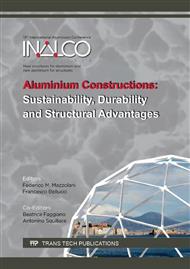p.333
p.339
p.345
p.351
p.357
p.363
p.371
p.378
p.383
Deformation of Perforated Aluminium Plates under In-Plane Compressive Loading
Abstract:
Aluminium plates containing a single hole or multiple holes in a row are recently becoming very popular among architects and consultant engineers in many constructional applications, due to their reduced weight, as well as facilitating ventilation and light penetration of the buildings. However, there are still uncertainties concerning their structural behaviour, preventing them from wider utilization. In the present paper, local buckling phenomenon of perforated aluminium plates has been studied using the finite element method. For the purposes of the research work, plates with simply supported edges in the out-of-plane direction and subjected to uniaxial compression are examined. In view of perforations, circular cut-outs and the total cut-out size has been varied between 5 and 40% of the total plate area. Moreover, different perforation patterns have been investigated, from a single, central cut-out to a more refined pattern consisting of up to 25 holes equally distributed over the plate. Regarding the material characteristics, several aluminium alloys are considered and compared to steel grade A36 on plates of different slenderness. For each case the critical (Euler) buckling load and the ultimate resistance has been determined.A study into the boundary conditions of the plate showed that the restrictions at the edges parallel to the load direction have a large influence on the critical buckling load. Restraining the top or bottom edge does not significantly influence the resistance of the plate.The results showed that the ultimate resistance of aluminium plates containing multiple holes occurs at considerably larger out-of-plane displacement as that of full plates. For very large total cut-out, a plate containing a central hole has a larger resistance than a plate with equal cut-out percentage but with multiple holes. The strength and deformation in the post-critical regime, i.e. the difference between the critical buckling load and the ultimate resistance, differs significantly for different number of holes and cut-out percentage.
Info:
Periodical:
Pages:
357-362
Citation:
Online since:
September 2016
Authors:
Price:
Сopyright:
© 2016 Trans Tech Publications Ltd. All Rights Reserved
Share:
Citation:


